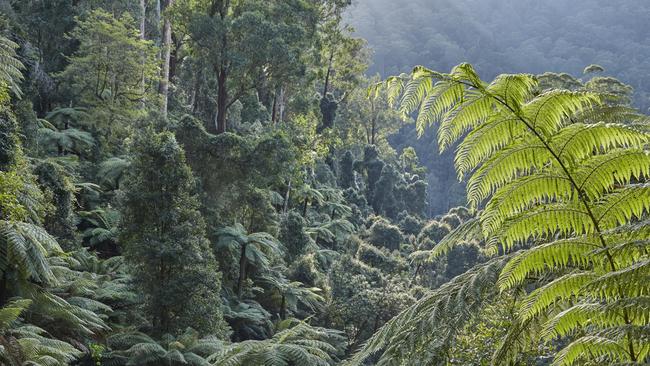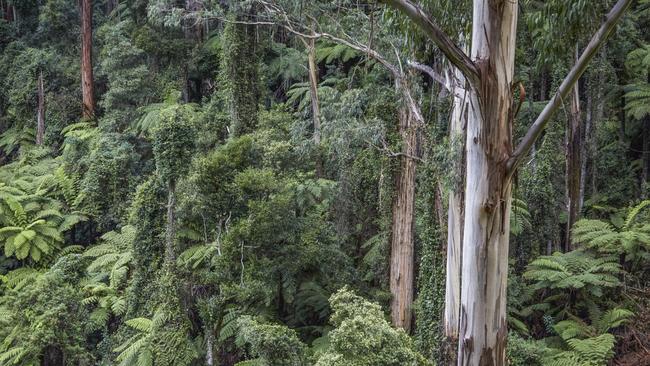The forest wars: loggers v greenies in Victoria, NSW
Environmental groups are relying on courts and the market to thwart inroads by the logging industry.

Deep in East Gippsland’s Kuark forest, ancient trees tower overhead, the scent of sassafras wafts on the breeze and birdsong fills the air. Old-growth trees such as these provide a rare example of a landscape undisturbed by human harvest. But Kuark is under threat of logging.
Had it not taken action, Environmental Justice Australia says, by now the birdsong in Kuark would have been replaced by the sound of chainsaws, and the fragrance of sassafras supplanted by the odour of diesel.
The Kuark action taken in the Victorian Supreme Court is one of two legal challenges that point to the shape of things to come as the Keating era Regional Forest Agreements expire and discussions about how to manage forests nationally come to a head.
Logging companies want increased access to timber and funding for new plantations.
Environmental groups have been flexing their political muscle — from the recent Queensland election, where they campaigned on tree clearing and the Adani mine, to this month’s Batman by-election in Victoria, where Labor is pitted against the Greens.
With RFAs coming to an end, green groups have started to apply to the timber sector the template of litigation and market intervention that has slowed Australia’s coal industry.
“We are going back to the tools at our disposal: court action and the marketplace,” The Wilderness Society’s national director Lyndon Schneiders says.
International buyers are being warned off Australian products that do not meet “acceptable” forest practices. And courts are being asked by environmentalist groups to break through what they have long considered a key political compromise at the heart of the RFA process.
Environmental lawyers have challenged the belief that RFAs exempt logging operations from oversight under the federal Environment Protection and Biodiversity Conservation Act.
In Victoria, Friends of Leadbeater’s Possum has argued through Environmental Justice Australia that some of the past and future logging in Victoria’s central highlands should not be exempt from the EPBC Act, as it has not been undertaken in accordance with the RFA.
This is because the state government had failed to conduct five-yearly reviews, as required under the agreements with the commonwealth. The Federal Court is expected to rule on the matter today.
If the court action is a success in Victoria, the leadbeater’s possum quickly will be joined by the koala in NSW, where the state government has been similarly lax in sticking to the required timetable for five-yearly reviews of its RFAs.
While the Federal Court considers the possums, the Victorian Supreme Court has been asked to rule that the state government has an obligation to preserve a significant percentage of old growth in state forests.
The Victorian government says it has introduced 11th-hour protections in response to Kuark protests, whereby trees more than 2.5m in diameter could not be cut.
East Gippsland, where Kuark is located, was the first area whose RFA was due to expire, in February last year, but was extended temporarily. It is now due to expire this month along with the Central Highlands RFA, but the Supreme Court action is not expected to be heard until May.
The industry is already feeling the squeeze. Planned future timber harvest was lost to the state’s catastrophic Black Saturday bushfires in 2009. Last year the Victorian government poured more than $60 million into keeping the Heyfield hardwood timber mill open in the La Trobe Valley after the previous owner, Hermal Group, said dwindling timber supplies from VicForests had made it unviable.
Under government ownership, Heyfield is laying off workers and local manufacturers are saying it has become increasingly difficult to source timber of a size appropriate for making furniture. There is speculation about further cuts to timber supplies. The alternative is to downgrade protections for the leadbeater’s possum from critically endangered to endangered and open up new areas to logging.
The state government’s plan for Heyfield is unclear but it is possible the taxpayer money already invested will be lost along with the mill workers’ jobs it was trying to protect. A key decision on the leadbeater’s possum is expected shortly, before the Victorian election in November, setting up a contest of trees, possums and jobs.
Hermal, meanwhile, has been given $190m to relocate its operations to focus on plantation hardwood timber in Burnie, Tasmania.
In NSW, the looming expiry of RFAs has breathed fresh urgency into what have been long-festering concerns in forest areas from north to south. In January, eight NSW environmental groups wrote to Premier Gladys Berejiklian, urging her to intervene to protect an area of Gladstone State Forest near Bellingen, which they said was vital to the protection of koalas in NSW.
The environmental groups said polling in the north coast seats of Ballina and Lismore in December last year had shown people were very aware of the plight of koalas, and highly supportive of new national parks for their protection. The call coincided with a month-long NSW government road show for regional forest communities as part of its RFA renewal process. Environmental groups have boycotted the public information meetings, claiming a lack of good faith and accusing state and federal governments of having already made up their minds.
There are deep divisions within the NSW government over what environmental message it wishes to present in the lead-up to next year’s state election. State Nationals are pushing a hard line on tree clearing and environmental groups are worried redrawn RFAs may allow timber harvesting in hitherto protected areas.
Malcolm Turnbull committed the commonwealth to a new vision and plan for forest industries at an industry gala dinner in Canberra at the end of last year. The Prime Minister says the plan will provide “vision and certainty” and develop the industry as “a growth engine for regional Australia”.
Details of the plan have been left to Assistant Minister for Agriculture and Water Resources Anne Ruston, who has spoken in support of continuing the RFAs.
“RFAs are the best mechanism to balance competing economic, social and environmental demands on native forests,” she told the industry in December. Federal Labor has offered conditional support.
“If it’s a good plan, it’s a well-thought-out plan and it’s an economically responsible plan, then of course we will support it,” opposition forestry spokesman Joel Fitzgibbon says.
But he is realistic about the difficulties ahead.

“Whether we like it or not, community expectations on the conservation front are rising, not falling. And I suspect they will continue to rise,” Fitzgibbon says.
Labor was the architect of RFAs in the mid-1990s as it became increasingly split after Graham Richardson famously identified the electoral power of the environmental vote in north Queensland. RFAs were the peace bargain that came at the culmination of a torturous “forest wars” period for the Keating government. The final straw came with a 1995 blockade of Parliament House by timber workers.
The recently released 1995 cabinet papers show that when the deal was done federal cabinet was told: “Inevitably, RFAs will involve compromises in ambit conservation and industry positions, and this can be expected to attract criticism from the more extreme elements on both sides.”
More than $400m has been spent but state-federal bickering has dogged the development of RFAs from the outset. The agreements are set to expire between this year and 2022, and are up for renewal.
Greg McCormack, chairman of industry group the Australian Forest Products Association, says RFAs “have not been brilliant for the industry”.
“RFAs were supposed to be the line in the sand which would sustain our industry,” McCormack says. “Since then, three million hectares were taken out of production and moved into national parks. Having said that, without RFAs those seeking to close our industry down would succeed very quickly via relentless legal challenges under the EPBC Act.”
Environmental groups are looking for new ways to attack on this front.
The timber industry calculates it is responsible for $24 billion in economic activity and 80,000 direct jobs. In its blueprint for the future it has called for support to expand the plantation reserve, build a biofuels revolution, bring carbon abatement cash to the industry and ensure a sustainable native forest estate.
“We simply cannot grow as an industry if we don’t get more trees in the ground,” McCormack says.
The challenge for government is not to repeat the mistakes of the past. This includes the tax-effective managed investment schemes whereby hundreds of plantations were established across the country, the vast majority of which failed due to a combination of factors including poor management and inappropriate locations so that trees lacked access to market.
The schemes were introduced to encourage agricultural diversification after the decline of the local forestry industry. A Senate report found managed investment schemes had quickly become an attractive tax deduction for wealthy investors, but as demand grew the nature of the industry changed rapidly, to the point where it is best described as an abhorrent Ponzi scheme. Two of the largest schemes, Timbercorp and Great Southern, collapsed in spectacular fashion, with combined losses of more than $1bn.
Today’s industry has set a national target of planting an additional 400,000ha, with up to a quarter of that done by farmers on a small scale. For funding, the industry is eyeing $100m from the Emissions Reduction Fund across four years, establishment of low-interest loans for plantations and new carbon-related financing programs, “including carbon pricing mechanisms and purchasing of the rights to stored carbon”.
The industry says it can now access 5.5 million hectares of Australia’s 125 million hectare state forest reserves. It wants the RFAs to be extended for another 20 years on a rolling five-year basis, with state and federal agreement that there will be no loss in net timber supply.
Conservation groups say it is too early to commit to extending the RFAs.
“The first thing you should do is assess whether the RFAs have met their objective,” says Alix Goodwin, chief executive of non-governmental conservation group National Parks Association of NSW. “It should be a scientific and economic review done by someone who is respected and independent from the process.”
Such a review would look at the options for future forest management.
A base case might be to leave the forests as they are. A second option might be to continue logging. And a third option would be for state forests to be transferred to the protected areas system.
“Having done that, you would have a preferred pathway forward — and only if that said the best future use was logging would you then move to renegotiate the Regional Forest Agreements,” Goodwin says.

The National Parks Association has done its own research, which has led it to some stark conclusions about the economics of the state forest operations. It says the value of Australia’s native timber stocks has declined by 30 per cent to $2bn between 2005 and 2015, and hardwood sawn wood production has dropped by 44 per cent over a similar period.
In contrast, plantation stocks increased in value to $10bn and softwood sawn wood production is up by 10 per cent.
The National Parks Association says Forestry Tasmania had lost $64m and Forestry Corporation (NSW) $84m between 2009 and 2012 in native forest logging operations.
Forestry Corporation also received annual funding from NSW Treasury in the form of a Community Service Obligation worth $15.6m in 2014-15.
In contrast to industry estimates, the association says direct employment in forestry and logging (including the native as well as plantation sectors) in NSW was 2131 according to the 2011 census, with extended employment of 5166, or 0.02 per cent of primary industries employment.
Across Australia, 7561 people were directly employed in forestry and logging, with indirect employment estimated at 18,328, NPA says. Employment in the native forest logging sector in NSW is estimated to be about 600, and in Tasmania less than 1000.
NPA says the primary drivers behind the decline in hardwood production in state forests are increasing competition from hardwood and softwood plantations, both domestically and internationally, and higher costs relative to international competitors.
There is weak demand for structural timber; decreasing demand from Japan for pulp because of falling paper consumption and efficiencies in the production process; and a reduction in the area of forest available for harvest.
“Many of these trends are predicted to continue, which means that demand will continue to fall and profitability from native forest logging will be increasingly difficult to achieve,” according to the NPA report.
“A strong case can be made that continued native forest logging operations are not a result of certainty and sound management via the RFAs but, rather, of successive and regular government intervention using public funds.”
Like the industry, environmental groups see the future in plantation timbers.
But Schneiders says the industry’s woes are largely of its own making.
“The industry is facing a shortfall of softwood timber because it put the wrong trees in the ground. They had the opportunity but billions of dollars was wasted on fraudulent tax schemes which put the wrong types of trees in the wrong places. Now they are going back again for another attempt.”
Nonetheless, environmental groups are willing to listen to proposals that include genuine carbon abatement. But they are wary of plans to encourage the use of forest residues for renewable power production.
Most of all they believe there is still a rich vein of community opposition to logging old trees such as those at risk in the Kuark forest in Victoria, or a return to now protected stands in the north and south of NSW.
After 20 years, it is clear that RFAs have not ended the forest wars — but they may have helped to point the way to a more profitable future in plantations.



